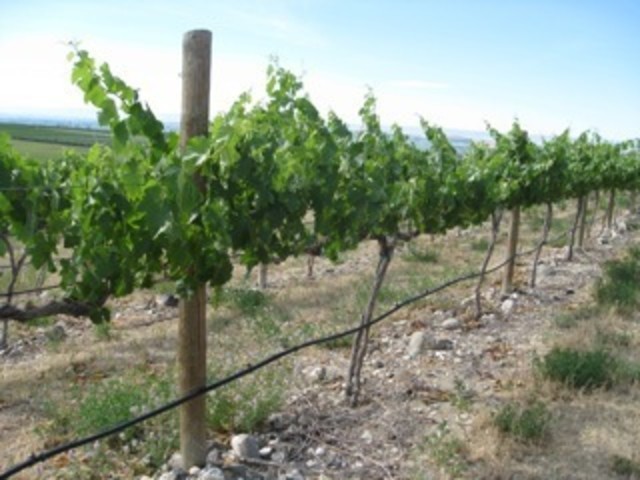A Taste of the DuBrul Vineyard

Two jubilant dogs stand at attention in the backseat as Hugh Shiels bounces along a dusty road, passing columns of hops, then an orchard full of trellised apples, before rising into the vineyard. Here, chartreuse shoots emerge from brown vines, verdant leaves erupt against blue sky, and tiny clusters of green berries—no bigger than gravel—clutch to stems.
This is the 45 acres of DuBrul Vineyard, the origin of grapes found in vineyard-designate wines (meaning the grapes have such character and make such good wine that vintners laud the vineyard by name on the bottle, rather than simply listing the AVA) such as Rasa Vineyards Creative Impulse; cabernet sauvignons from Owen Roe, the Oregon winery that takes a special interest in Washington fruit; and of course the Shielses’ estate-bottled Côte Bonneville wines.
What gets the Shielses, who planted the first vines here in the heart of Yakima Valley’s Rattlesnake Hills in 1992, so excited is the rocks. Granted, earth always gets grape growers and vintners (and wine drinkers) excited, but for the Shielses this is an exceptional kind of geekdom.
There’s a lot going on underground in this little vineyard. There’s the hillside, underlain by basalt, covered with ancient Columbian River deposits of rocks—pink and orange and white granitic rock from the Canadian Rockies and northern tributaries, along with dark blue and gray pockmarked volcanic basalt from the ancient Cascade volcanoes—with lots of wind-driven loess mixed in. The vines growing on this soil are less vigorous. They have to work harder; the clusters and berries are smaller, the fruit tannins are leaner. There’s a wild depth of character here, some unusual finesse.
Then, there’s also the little pie-shaped wedge of earth that cuts into the vineyard, full of alluvial soil—silt, sand and gravel—washed from the hills around. The grapes here seem to have that denser expression of earth on the nose and palate.
All that in one vineyard, and often shifting within the very rows. Wineries—besides Côte Bonneville—know what soil they’re getting, straight down to the tree. Shiels points to blue tape flags revealing the demarcation lines, showing how row by row, vine by vine they adjust micro-irrigation patterns. There’s serious rigor to where drip tubes begin and end, or double upon themselves.
This slightly obsessive vineyard management program doesn’t seem to end at the roots. There’s an almost fanatical, whole vineyard approach to the land. Because wild woods roses harbor a minute wasp with a predilection for grape leafhoppers—tiny bugs that feed on the grape shoots and grapes—bright pink wild rose bushes flower at the periphery. Meanwhile, red-tailed hawks soar above the vineyard, snowmelt pours through a lateral vein of the Roza irrigation canal at the upper portion of the vineyard, and barn owls bark from a stretch of trees just northeast of the grapes. Then there’s the greenbelt. In 2006 the Shiels developed a shelterbelt for migrating pheasant. Ask why and Hugh will look at you with dumbfound horror. Holistic is probably the only word that can be used to describe the way his mind thinks about these grapes.
Can you taste the hawks or the Great Horned Owls (there were those here once, too) or the wild roses in DuBrul Vineyard designated wines? No, but you can taste the silt-encrusted stones and basaltic rocks. And, for those bent on discovering the effect themselves there are options. Tour the vineyard as part of the Yakima Valley Vineyard Tour Series in mid-July, or taste it: Find the hillside, with its palm-smooth rocks, in the Owen Roe DuBrul Vineyard Cabernet Sauvignon ($70) or Merlot ($45), for example. Or compare the Côte Bonneville DuBrul Vineyard Red blend ($115) from the hillside, to the Côte Bonneville Carriage House ($45) red blend, grown on that alluvial fan—though you may break your budget in the process.




